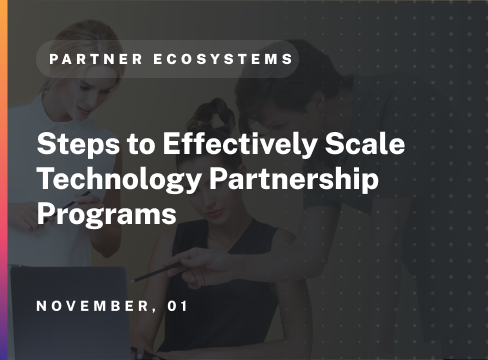The path to building a successful technology company is rarely walked alone. Forming and scaling partnership programs have become the linchpin activities that define the trajectory of a growing tech venture.
However, doing this effectively is no small feat, often leading to issues like misalignment of objectives and resource wastage.
An expert panel convened to share actionable insights about scaling technology partnership programs. This panel included Kelly Sarabyn, the Platform Ecosystem Advocate at HubSpot, Joni Deus, VP of Product and Partnerships at MailChimp, Mike Vaccaro, VP of Global Partnerships and Enterprise Sales at Tray, Eric Chan from VP for Partner Ecosystem at Vajro, and Carina Conaghan, Partnerships Leader UKI at Amazon Web Services.

How do you scale technology partnerships effectively? Let’s find out.
Step 1: Create a Partner Program
Meticulously crafted partnership programs are more than just a good-to-have. It’s a business imperative.
Partnership programs that balance product development needs with go-to-market strategies don’t just foster collaboration — they ensure that the alliance is rooted in shared goals and visions.
Strategic Focus
Deus pointed out the significance of concentrating on strategic partnership programs. It’s not about partnering to expand numbers but establishing relationships that align with the strategic objectives of both parties.
A self-service approach ensures that partners have the autonomy to integrate seamlessly, thereby enriching the alliance.
Customer-Centricity in Partnership Programs
Your customers are your north star. Always. And this sentiment becomes even more crucial when scaling partnerships.
Chan highlighted the essence of a partnership that aids in creating a complete end-to-end workflow for customers.
The idea is to view the alliance through the lens of customer value constantly.
Does the partnership enrich the customer experience? If the answer is yes, you’re on the right path.
Business Alignment
Aligning partnership programs with overarching business goals is essential.
Using Sarabyn’s notion of considering the customer as the guiding force, it becomes evident that the partner program should resonate with customers and reinforce your business ethos and long-term objectives.
As Vaccaro mentioned, recognizing and iterating the tangible business value in partnerships ensures that the collaboration remains fruitful for both entities.
Step 2: Assemble Your Product Team
Building a great product is often the first thing every tech company thinks.
But how often do we consider integrating a product team into our partnership strategies? Allowing technology partnerships to function in proximity to the product team can offer unprecedented advantages.
Visibility into the Roadmap
Deus emphasized that technology partnerships should be integrated into the product department. This provides a clear visibility into the product roadmap.
It’s not just about knowing what’s next but understanding the why behind it.
When your partnership teams understand your products’ direction, they can strategically align collaborations that complement and enhance these product roadmaps.
Doing so makes the relationship mutually beneficial, driving growth for both parties.
Influence on Product Decisions
Having partnerships ingrained in the product framework provides another significant advantage: the ability to influence product decisions.
As partnerships mature, they offer a wealth of insights from the market, user feedback, and collaboration learnings.
Vaccaro weighed in on the importance of involving business perspectives in product conversations.
Embedding these insights into product decisions, organizations can ensure that their products meet market demands and provide unique value propositions stemming from solid partnerships.
Future of Tech Partnership Programs
The landscape of technology partnerships is ever-evolving, and understanding where it’s headed can be pivotal.
Deus hinted at an interesting trajectory — envisioning a future where tech partnerships naturally fall into the product department until a dedicated chief partnerships officer is helming this function.
By anticipating these shifts, organizations can better prepare and position their teams to capitalize on these evolutions, ensuring sustained growth and innovation.
Step 3: Understand Your Niche and Marketplace
Once your internal teams are aligned, the focus should shift externally to understanding the role of marketplaces in scaling technology partnerships.
In a world driven by customer experience, the marketplace isn’t just a place to sell. It’s a space to engage, educate, and understand your customers.
Crafting an Optimal Customer Experience
One of the cornerstones of any thriving marketplace is the experience it offers its customers. Drawing from Conaghan’s insights, the marketplace is not just a tool but a window to your brand’s expertise.
When customers access your platform, they’re not just looking for products or partnerships. They’re seeking an experience that aligns with their needs and expectations.
Your marketplace should seamlessly guide them, offer relevant solutions, and ensure their journey is as intuitive and enriching as possible.
Prioritizing Quality over Quantity
Deus touched on a critical aspect: the essence of a marketplace isn’t in its volume but its value.
A cluttered marketplace with countless offerings but no clear direction can be more detrimental than beneficial. Instead, the focus should be on fostering tight-knit integrations and quality collaborations. This ensures that users derive genuine value from the marketplace, strengthening brand loyalty and encouraging continued engagement.
Evolution of Marketplaces
Marketplaces are not static entities. They evolve, adapt, and transform based on user needs, technological advancements, and market dynamics. According to Conaghan, the future of marketplaces lies in enhancing the overall experience rather than just listing services or apps.
As brands, it’s crucial to keep an ear to the ground, understand shifting user expectations, and continually innovate to ensure your marketplace remains relevant, engaging, and ahead of the curve.
Step 4: Leverage Partnership Programs and Technology
Partner technology can act like the grease in a well-oiled machine – facilitating smoother operations and better connectivity. This includes various tools and platforms, such as:
- Embedded IPasses: These platforms enable integrations between web services and applications. By leveraging them, businesses can facilitate seamless data flow between systems, offering enhanced user experiences.
- In-app Marketplaces: Beyond being mere platforms for app listings, these are avenues for businesses to showcase their integrations, garner user feedback, and optimize offerings.
- Unified APIs: This technology allows diverse software solutions to communicate effortlessly. With unified APIs, businesses can ensure their services are interoperable, providing users with holistic solutions.
- Developer Portals: These portals serve as hubs for developers to access resources, documentation, and tools, streamlining the integration process and fostering innovation.
Integrating these technologies ensures that partnerships aren’t just transactional but transformative. They bridge gaps, foster innovation, and ensure collaborations yield tangible results.
Future-Proofing with Partnership Programs and Technology
As the tech landscape evolves, staying ahead of the curve becomes paramount.
Vaccaro said, “Take advantage of the tools that your company owns.”
In essence, leveraging existing partner technologies enhances current operations and prepares businesses for future demands.
It ensures agility, fosters innovation, and positions brands to seize emerging opportunities.
Optimizing Internal Workflows
An often overlooked advantage of partner technologies is their potential to streamline internal processes.
When organizations leverage tools like app marketplaces for education and partner spotlights, they improve external collaborations and optimize internal workflows.
This boosts efficiency, fosters a culture of continuous learning, and ensures that teams are always equipped with the tools and knowledge they need to excel.
Conclusion
Scaling tech partnerships can be a challenge, but it’s worth the effort. It’s important to remember that tech partnerships are a two-way street – both parties must benefit in order for the partnership to work. Make sure you understand what each partner brings to the table and how their expertise can help further your goals.
Join The 1850+ Leaders Transforming Partnerships
As a member of Partnership Leaders you will:
- Build and learn with the top partner people at the best companies around the world.
- Increase your impact and accelerate your career with proven resources, tools, and best practices.
- Grow a network of peers, partners, and advisors with common objectives.


